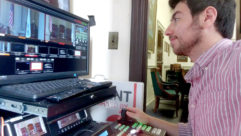
Broadcast Pix Slate 100 HD
Mar 1, 2008 12:00 PM,
By Jeff Sauer
Video switcher built on a Windows XP computer features accessible interface.

For installation professionals, “video switcher” generally refers to a presentation switcher — a rackmountable device with buttons on the front that mixes multiple visual sources, such as computer presentation slides, with a live video of the presenter. Increasingly, however, the faster pace of live-production environments with multiple live cameras has fueled calls for the broader feature set of a video-production switcher or broadcast switcher, such as you might see in a TV control room. Such switchers are more powerful, but also more complex — if not intimidating.
Broadcast Pix grew out of the video-production switcher industry. The company understands both how powerful and how foreign a broadcast switcher can be to the uninitiated, and it’s done something about it. The Slate 100 HD is a full-blown production switcher, except rather than being a freestanding, tabletop device, it is built into a Windows XP computer. That gives it a number of advantages. By putting everything needed for producing a live broadcast on a computer screen, the Slate 100 HD brings point-and-click functionality to a switcher and adds powerful clip- and still-store features that would ordinarily require more dedicated hardware. (Ideally, it should be a dual-monitor configuration, given all of the desktop elements, but it doesn’t have to be.)
The Slate 100 HD is the base version of a family of switchers, all using the same Windows-based elements. Higher-end configurations add hardware options such as a dedicated tabletop control panel and an I/O breakout box, thus moving even further toward traditional production switchers. However, the Slate 100 HD includes all the visual-interface tools that make the entire line both powerful and accessible.
Visually, the Slate 100 HD interface is a little like a nonlinear editing system desktop with a preview-monitor window, a program-monitor window, and a multi-tab bin window of visual elements across the top half of the screen. (The interface is completely configurable, so all windows can be un-docked and moved anywhere on the screen to suit your personal preference.) Yet unlike a typical editing interface, the preview and program windows are live, with video playing all the time during your live show, just as you would see if there were separate video monitors attached to the outputs of a production switcher.
Below the preview and program windows, there are also smaller monitor windows for each of your sources, including camera feeds and cued video clips from disc. These windows are all configurable to match your sources, live or stored, and they too can be playing live video. You can even play through stored QuickTime clips without affecting your live output — for example, to find a mark-in point.
Switching between sources is as simple as clicking on them with your mouse. In fact, depending on your choice of workflow, you can click them into the larger preview-monitor window at the top of the interface or click them straight to air in the program-monitor window. To make it even more intuitive, many Broadcast Pix dealers offer the option of a touchscreen monitor, allowing you to literally point with your finger at what you want to go live. The Slate 100 HD also includes a standard Windows keyboard with custom keycaps that put the tactile functionality of a tabletop control panel at your fingertips.
Broadcast Pix Slate 100 HD
Mar 1, 2008 12:00 PM,
By Jeff Sauer
Video switcher built on a Windows XP computer features accessible interface.
THE POWER OF THE PROCESSOR
A few years ago, that sort of multistream
video-playback performance would not have been possible from a
Windows-based computer. The horsepower just wasn’t there to churn
through multiple channels at the same time. However, today’s processors
are much faster and able to render multiple, high-definition video
layers. Slate 100 HD uses that horsepower to play both video files off
the hard drive and live camera inputs, mix them, and output them to an
external display — whether that’s a local projector, over a closed
network, or to television.
Indeed, aside from the simplicity of
point-and-click, that ability to play stored clips from the hard drive
and mix them with live sources is a large part of what separates the
Slate 100 HD from a traditional standalone switcher. And that’s a huge
advantage for live production, particularly live production on a
budget. In addition to full switching capabilities — including DVEs,
keying, multiple video layers, and picture-in-picture — Slate 100 HD
also boasts a computer’s still-store, logo-store, and clip-store
ability that is limited only by the size of a hard drive. That
eliminates any need for a separate digital disk recorder (DDR) or
still-store device feeding an input channel.
Slate 100 HD also includes a full version of
Inscriber TitleMotion Pro, a broadcast-quality title-and-character
generator that allows you to build custom titles for your live
production. Better still, because Slate 100 HD leverages the power of a
computer CPU and puts everything in front of you on the screen — titles
can be created, edited, and updated during a live production, including
straight-to-air. Slate 100 HD can add up to three keying layers of
graphics over video, which allows the use of common production
elements, such as a station ID bug, a lower-third title identifying a
speaker, and an over-the-shoulder insert.
Slate 100 HD can get even more powerful with a
feature called CG Connect, which links the character generator to a
database. Imagine a list of presenters on a panel discussion or the
roster of a sports team entered into a simple database with names,
titles, or companies (or uniform numbers and performance statistics),
all linked to one elegant title graphic. Rather than building a title
card for each participant, CG Connect can build a single multi-field
graphic and then update that graphic on the fly with the information in
the database. In other words, you can type in a number, and that
player’s name, position, and batting average get automatically entered
in your title. It works for a panel discussion’s name, title, and
company fields, too, and it’s just as exciting as baseball for the guy
who would otherwise be slogging away building custom graphics.
Most importantly in this emerging age of
high-definition, the Slate 100 is now HD, and it allows you to mix SD
and HD content in the same program. Better still, Slate 100 HD allows
users to automatically crop or stretch inputs — live or from file — to
match the aspect ratio of the other material in a program, simply by
selecting the aspect from a drop-down menu.
The Slate 100 HD includes the Windows XP
computer in a rackmountable workstation, keyboard and mouse, and four
HD inputs (expandable to eight) that can be configured to accept SD or
DVI singles. At a price of $14,400, the Slate 100 HD is at a similar
price point as other affordable production switchers, but it really
adds value by adding character generation and clips/still/logo store.
More importantly, it offers an accessible interface that moves powerful
live-production features into the mainstream of event production.
PRODUCT SUMMARY
Company: Broadcast Pix
www.broadcastpix.com
Product: Slate 100 HD
Pros: Point-and-click switching,
computer interface puts everything at your fingertips, can easily
update titles, HD-video support up to 1080i.
Cons: Input-and-output flexibility requires purchase of extra hardware, software options add to cost.
Price: $14,400 (HD); $10,995 (SD)
SPECIFICATIONS
System includes: Windows XP Pro workstation, keyboard with custom keycaps, mouse, switching card, and one HD I/O card
In/out: Standard HD I/O provides four HD-SDI inputs and one output, each in/out can accept DVI with converter
Video-format support: 480i, 576i, 720p, 1080i (NTSC, PAL), DVI (optional)
Video file playback: QuickTime DV25, QuickTime DV50, MPEG-2
Title generation: Inscriber TitleMotion included, CG Connect optional
Graphic support: JPEG, PDS, BMP, GIF, TIFF, and PNG
DVE: >100 wipes, alpha wipes
Video latency: One frame synchronous sources, two frames asynchronous sources
Video processing: 10-bit
Warranty: One year parts and labor








